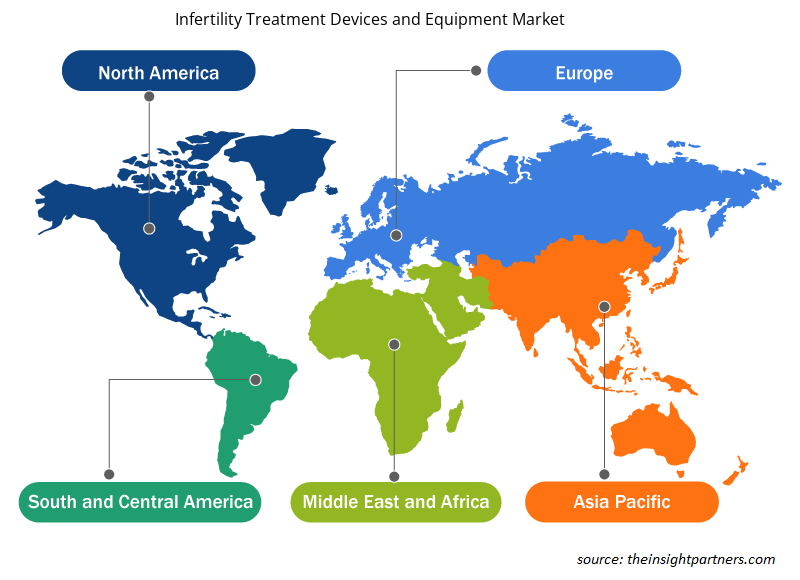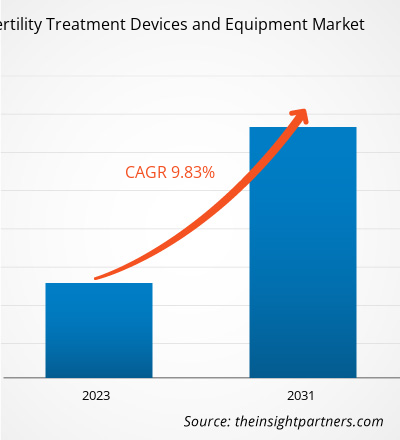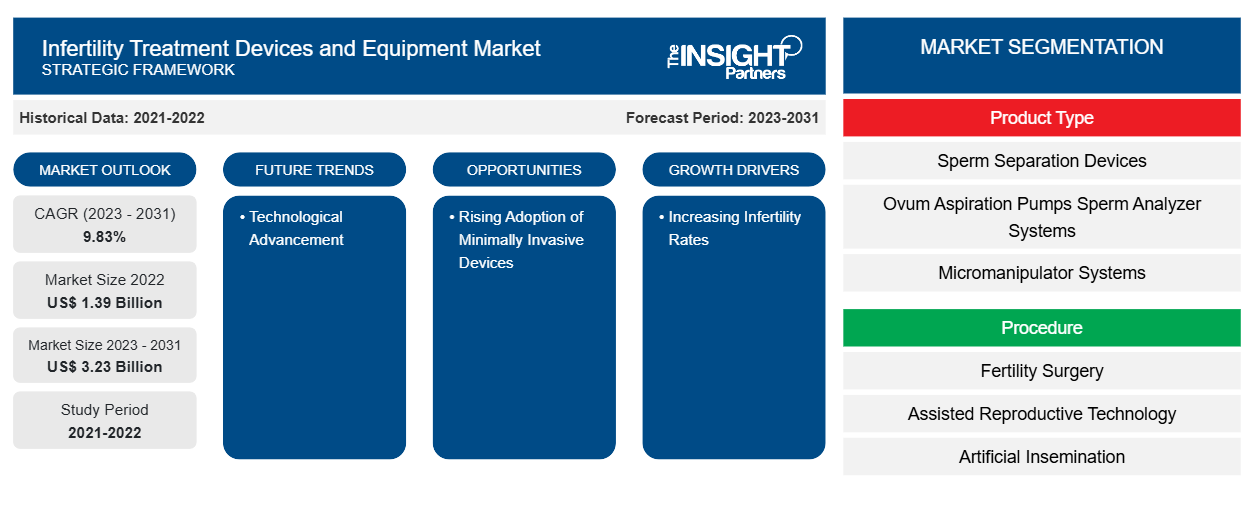不妊治療機器および装置の市場規模は、2022年の13億9,000万米ドルから2031年には32億3,000万米ドルに達すると予測されています。市場は2023年から2031年にかけて9.83%のCAGRを記録すると予想されています。卵細胞質内精子注入法などの新しい不妊治療の開発は、不妊治療機器および装置の市場の主要なトレンドであり続けると思われます。
不妊治療機器・設備市場分析
不妊症とは、避妊せずに1年間性行為を行っても妊娠できない状態です。世界保健機関(WHO)は、これを公衆衛生問題として認識しています。世界の不妊治療機器および装置市場は、世界的な出生率の低下、高度な生殖技術の成功率の向上、政府やその他の医療機関からの支援の増加など、さまざまな要因により、大幅な成長を遂げています。これらの要因により、生殖能力を向上させる新しい治療法の開発が促進されると予想されます。
不妊治療機器・設備市場の概要
WHO の報告によると、世界中の成人の約 17.5% が不妊症を経験しています。不妊症の生涯罹患率は、高所得国では 17.8%、低所得国および中所得国では 16.5% であることがわかりました。不妊症の増加は、不妊治療を求める患者の数の増加につながります。これにより、手頃な価格で高品質の不妊治療の必要性が浮き彫りになり、不妊治療機器および装置市場の拡大に貢献しています。
要件に合わせてレポートをカスタマイズする
このレポートの一部、国レベルの分析、Excelデータパックなど、あらゆるレポートを無料でカスタマイズできます。また、スタートアップや大学向けのお得なオファーや割引もご利用いただけます。
-
このレポートの主要な市場動向を入手してください。この無料サンプルには、市場動向から見積もりや予測に至るまでのデータ分析が含まれます。
不妊治療機器および装置の市場推進要因と機会
高度な不妊治療技術の高い成功率が市場を有利にする
生殖治療は大きく進歩し、生殖補助医療(ART)などの不妊治療の選択肢と成功率が拡大しました。2022年10月にCureusに掲載された記事によると、今後数年間で体外受精は世界中の複数の地域で広く使用され、全児童の最大10%が誕生すると予想されており、体外成熟(IVM)の成功率は、技術の進歩、必要なツールの改善、手順を実行する人の経験とトレーニングの蓄積により最大56%増加しています。さらに、排卵追跡アプリなどの生殖能力認識方法は、よりアクセスしやすく信頼性が高くなり、情報に基づいた家族計画の決定が可能になりました。
低侵襲デバイス - 不妊治療におけるチャンス
子宮筋腫、ミュラー管奇形、卵巣嚢胞、子宮内膜症など、いくつかの異常や症状は、妊娠の可能性を低下させる可能性があります。これらの問題は、慢性骨盤痛や重度の出血などの不快な副作用を引き起こすこともあります。そのような場合、外科的介入がこれらの症状に対する最も効果的な治療法となる可能性があります。腹腔鏡検査や子宮鏡検査などの低侵襲技術を採用すると、痛み、回復時間、感染リスク、失血を減らしながら、不妊の根本的な原因に対処することができます。これらの手順では、従来の手術で使用される大きな開放切開ではなく、小さな切開と手術領域をモニターに映す高解像度カメラを使用します。
不妊治療機器および装置市場レポートセグメンテーション分析
不妊治療機器および装置の市場分析の導出に寄与する主要なセグメントは、製品タイプ、手順、およびエンドユーザーです。
- 製品タイプに基づいて、不妊治療機器および装置市場は、精子分離装置、卵子吸引ポンプ、精子分析システム、マイクロマニピュレーターシステム、インキュベーターなどに分かれています。卵子吸引ポンプセグメントは、2023年に最大の市場シェアを占めました。
- 手順別に見ると、市場は生殖補助技術、不妊手術、人工授精に分類されます。人工授精セグメントは2023年に最大の市場シェアを占めました。さらに、生殖補助技術セグメントは2023年から2031年にかけて最高のCAGRを記録すると予想されています。
- エンドユーザーの観点から見ると、市場は不妊治療クリニック、病院やその他の医療施設、臨床研究機関に分かれています。不妊治療クリニックのセグメントは、2023年に市場を支配しました。
不妊治療機器および装置の地域別市場シェア分析
不妊治療機器および装置の市場レポートの地理的範囲は、主に北米、アジア太平洋、ヨーロッパ、中東およびアフリカ、南米および中米の 5 つの地域に分かれています。
北米は不妊治療機器・装置市場を支配してきました。米国保健福祉省によると、2021年に米国で生まれた乳児の約2.3%がARTを使用して妊娠し、453のクリニックで約413,776サイクルが実施され、112,088人の妊娠につながりました。体外受精などのAR手順の増加、男性の不妊率の上昇、世界的な市場プレーヤーの存在は、北米の不妊治療機器・装置市場の優位性に貢献している要因です。アジア太平洋地域は、今後数年間で最も高いCAGRで成長すると予想されています。
不妊治療機器および装置市場の地域別分析
予測期間を通じて不妊治療機器および装置市場に影響を与える地域的な傾向と要因は、Insight Partners のアナリストによって徹底的に説明されています。このセクションでは、北米、ヨーロッパ、アジア太平洋、中東およびアフリカ、南米および中米にわたる不妊治療機器および装置市場のセグメントと地理についても説明します。

- 不妊治療機器および装置市場の地域別データを入手
不妊治療機器および装置市場レポートの範囲
| レポート属性 | 詳細 |
|---|---|
| 2022年の市場規模 | 13億9千万米ドル |
| 2031年までの市場規模 | 32億3千万米ドル |
| 世界のCAGR(2023年~2031年) | 9.83% |
| 履歴データ | 2021-2022 |
| 予測期間 | 2023-2031 |
| 対象セグメント |
製品タイプ別
|
| 対象地域と国 |
北米
|
| 市場リーダーと主要企業プロフィール |
|
不妊治療機器および装置市場のプレーヤー密度:ビジネスダイナミクスへの影響を理解する
不妊治療機器および装置市場は、消費者の嗜好の変化、技術の進歩、製品の利点に対する認識の高まりなどの要因により、エンドユーザーの需要が高まり、急速に成長しています。需要が高まるにつれて、企業は提供を拡大し、消費者のニーズを満たすために革新し、新たなトレンドを活用し、市場の成長をさらに促進しています。
市場プレーヤー密度とは、特定の市場または業界内で活動している企業または会社の分布を指します。これは、特定の市場スペースに、その市場規模または総市場価値に対してどれだけの競合相手 (市場プレーヤー) が存在するかを示します。
不妊治療機器・設備市場で事業を展開している主要企業は次のとおりです。
- サーモフィッシャーサイエンティフィック
- クックグループ
- ビトロライフ
- IVFテックAPS
- ハミルトンソーン株式会社
- エスコマイクロ株式会社
免責事項:上記の企業は、特定の順序でランク付けされていません。

- 不妊治療機器および装置市場のトップキープレーヤーの概要を入手
不妊治療機器および装置の市場ニュースと最近の動向
不妊治療機器および装置市場は、主要な企業出版物、協会データ、データベースを含む一次調査および二次調査後の定性的および定量的データを収集することによって評価されます。以下は、不妊治療機器および装置の市場における動向の一覧です。
- Trajan Scientific and Medical は、ドイツの新興企業 Fertilly に CE-IVD 登録済みの Mitra デバイスを供給しました。Fertilly は、VAMS 技術による乾燥血液マイクロサンプリングを使用したヨーロッパ初の在宅不妊検査キットを発売しました。Mitra マイクロサンプリング デバイスを使用すると、指を刺して血液サンプルを迅速かつ簡単に採取でき、その後、乾燥血液として分析のために研究所に郵送できます。(出典: Trajan Scientific Australia Pty Ltd、プレスリリース、2023 年)
- インドにおけるメルクのヘルスケア事業であるメルク スペシャリティーズ プライベート リミテッドは、インドで高度な不妊治療用のペルゴベリス ペンを発売しました。この発売は、重度の卵胞刺激ホルモン (FSH) および黄体形成ホルモン (LH) 欠乏症の女性に、改良された、便利ですぐに使用できる併用治療オプションを提供することで、満たされていない医療ニーズを満たすという同社の目的を強調するものです。(出典: メルク スペシャリティーズ プライベート リミテッド、プレスリリース、2021 年)
不妊治療機器および装置市場レポートの対象範囲と成果物
「不妊治療機器および装置の市場規模と予測(2021〜2031年)」レポートでは、以下の分野をカバーする市場の詳細な分析を提供しています。
- 対象範囲に含まれるすべての主要市場セグメントの世界、地域、国レベルでの市場規模と予測
- 市場の動向(推進要因、制約、主要な機会など)
- 今後の主な動向
- 詳細なPEST/ポーターの5つの力とSWOT分析
- 主要な市場動向、主要プレーヤー、規制、最近の市場動向を網羅した世界および地域の市場分析
- 市場集中、ヒートマップ分析、主要プレーヤー、最近の動向を網羅した業界の状況と競争分析
- 詳細な企業プロフィール
- 過去2年間の分析、基準年、CAGRによる予測(7年間)
- PEST分析とSWOT分析
- 市場規模価値/数量 - 世界、地域、国
- 業界と競争環境
- Excel データセット
最新レポート
お客様の声
購入理由
- 情報に基づいた意思決定
- 市場動向の理解
- 競合分析
- 顧客インサイト
- 市場予測
- リスク軽減
- 戦略計画
- 投資の正当性
- 新興市場の特定
- マーケティング戦略の強化
- 業務効率の向上
- 規制動向への対応























 無料サンプルを入手 - 不妊治療機器市場
無料サンプルを入手 - 不妊治療機器市場